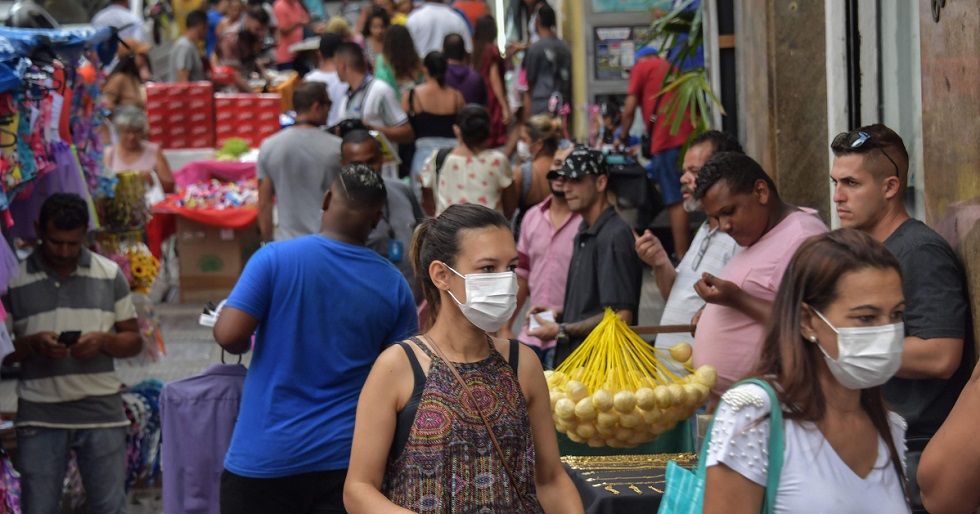RIO DE JANEIRO, BRAZIL – The rate of spread of the novel coronavirus (Sars-CoV-2) in Brazil is today the same as in Italy weeks ago – and it is accelerating.

According to a study conducted by the Observatory Covid-19 BR, which analyzes the numbers of the pandemic in the country and which includes seven universities, the number of cases is expected to exceed 3,000 by Tuesday, March 24th. The trend is for it to double every 54 hours and 43 minutes.
Physicists from the University of São Paulo (USP), State University of Campinas (Unicamp), State University of Paulista (Unesp), University of Brasilia (UnB), Federal University of ABC (UFABC), University of California Berkeley (in the United States), and University of Oldenburg (in Germany) take part in the research.
“Our calculations corroborate the notion that the start of the Brazilian epidemic curve is the same as in Italy and Spain – when these countries were at the onset [of the epidemic],” professor Roberto Kraenkel of the Institute of Theoretical Physics of Unesp said.
The balance reported on Thursday, March 19th, by the Ministry of Health pointed to 621 cases of the Covid-19 in Brazil – seven people have already died.
Worldwide, Italy is the country with the highest number of victims – on Friday, March 20th, the European country passed the 4,000 mark – the total number of recorded cases exceeds 47,000.
A survey by Johns Hopkins University in the United States released on Friday showed that there are at least 10,031 deaths from Covid-19 complications in the world. There are more than 245,000 people infected.
The Unesp minimum level projections for Brazil in the next few days are as follows:
- Saturday (21st) – 1,091 cases;
- Sunday (22nd) – 1,478 cases;
- Monday (23rd) – 2,003 cases;
- Tuesday (24th) – 2,714 cases; the maximum projected is up to 3,400 thousand cases on Tuesday.
Projection of cases
One of the calculations conducted by the Covid-19 BR Observatory research deals with the doubling time of infected people.
“One way to monitor the epidemic is to keep track of the doubling time on a daily basis. If the containment measures take effect, we will observe the doubling time increase. This is one way to determine whether we are succeeding in ‘taming’ the coronavirus,” Kraenkel said.
According to data from the Ministry of Health on Thursday, that time is 2.28 days – but it is dropping. That means that in Brazil, every 54 hours and 43 minutes, the number of infected people doubles.
The lower this interval becomes, the faster the pandemic spreads in the country. “If there are, say, ten cases, how long does it take to have 20, then 40 and 80?” explained the Unesp professor, talking about how the calculation is made.
The first case of coronavirus in Brazil was confirmed on February 26th.
A factor that interferes with this calculation is the number of tests performed. In Italy, for instance, as of March 9th, 60,000 patients had been tested — that gives an average of 1,000 kits for every million inhabitants. In South Korea, the number of tests was four times higher.
The Ministry of Health reported that 13,000 tests had been performed on the public network until the last update — 62 for every million Brazilians. There are no statistics for the private network.

Other countries
“Right at the beginning of the epidemic in Italy, the doubling time was close to 1.8 days. Today, it’s about four days,” Kraenkel said.
Keeping an eye on growth
The doubling time is reflected in the “curve” of cases, which the authorities so eagerly seek to “flatten”, thus preventing overload in the health systems.
There are two possibilities for a disease to advance – one can grow abruptly, above the health system’s absorption capacity, and the other can be smoother, spread over a larger number of days.
Health authorities throughout Brazil have intensified requests in recent weeks for the population to remain at home. Social isolation is advocated as the most effective way to flatten the curve of the coronavirus epidemic.
Projections for Rio and São Paulo
On Sunday, March 15th the UnB released a preliminary study that projects 1,300 cases over the next 30 days in Greater São Paulo alone – and 30,000 in 60 days.
The State Health Secretariat of Rio de Janeiro, on the other hand, traced two curve possibilities over the period of one month for the state: 4,000 cases if the isolation measures are effective – or 24,000 if the population does not avoid crowds.
Source: G1

